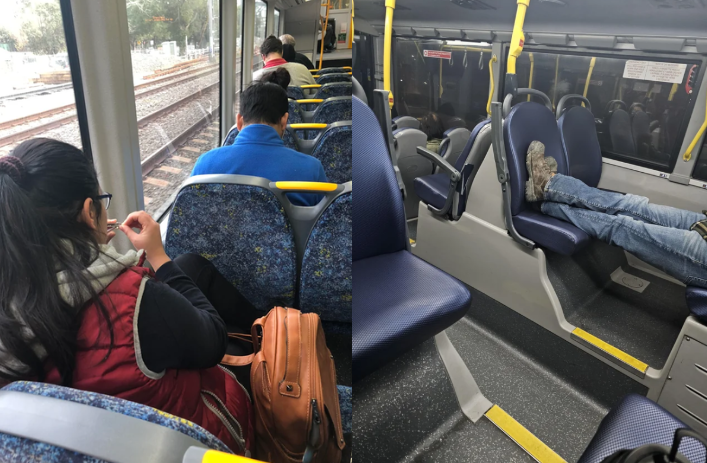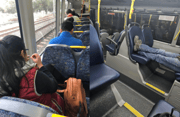
Ever had that sinking feeling when someone plonks down beside you on a train and starts blasting videos at full volume?
Or struggled to exit at your stop while passengers pushed their way on board as if the doors were theirs alone?
For many Australians, these moments have become all too familiar—and increasingly frustrating.
A Melbourne-to-Sydney commuter recently ignited debate on social media after posting about what he saw as a surge in 'rude and ignorant' behaviour on public transport.
His social media post described a litany of annoyances: loud phone conversations, videos played without headphones, and people ignoring basic courtesy when boarding and alighting.
'I am convinced that it's become widely acceptable to be completely ignorant and rude on public transport.'
Stories poured in of passengers stepping over prams, urinating in train carriages, and blocking doors without a second thought, painting a troubling picture of public transport manners in decline.
What the actual rules are (yes, there are rules)
While these behaviours felt like violations of common sense, Australia does have public transport etiquette guidelines.
Seasoned commuters generally follow unwritten rules such as letting passengers alight before boarding, keeping bags on laps or under seats, avoiding loud conversations or music, moving to the centre of carriages, offering priority seating, and not leaning on poles others need.
These rules applied across Melbourne, Sydney, Brisbane, and Perth—but many passengers seemed unaware they existed.
Why this might be happening now
Experts suggested several factors behind this decline in courtesy.
Post-pandemic travel patterns left many commuters out of practice with crowded transport etiquette, while smartphones and personal entertainment devices created new forms of inconsiderate behaviour.
Social media amplified the issue, making Australians more aware of minor and major annoyances alike.
Most annoying public transport behaviours
The real consequences
The consequences of bad behaviour went beyond irritation.
In South Australia alone, 93 assaults on bus drivers occurred in 2024, prompting authorities to introduce stricter measures to remove disruptive passengers from networks.
Authorities encouraged reporting poor behaviour, acknowledging that civilised public spaces required community cooperation.
The original social media thread also included examples from cinemas, medical waiting rooms, and hair salons—suggesting the decline in courtesy was not limited to transport.
How to handle inconsiderate fellow passengers
Passengers could take steps to manage inconsiderate behaviour.
Being direct but polite, using humour to defuse tension, knowing when to involve authorities, leading by example, and choosing which battles to fight were effective strategies.
The silver lining
Despite the complaints, many Australians also shared positive experiences.
Helpful grandmothers assisting with prams and passengers offering seats reminded commuters that courtesy still existed.
With public transport usage yet to return to pre-pandemic levels, this could be an opportunity to reset expectations and reinforce basic manners in shared spaces.
What This Means For You
Australians have been reporting more frequent incidents of loud, disruptive, and rude behaviour on trains and buses, highlighting a growing frustration with everyday travel.
While public transport etiquette rules do exist, many passengers either ignore them or are unaware of what they entail, making journeys more stressful for everyone.
Changes in post-pandemic travel habits, the rise of smartphones, and increased social media use have all contributed to what many perceive as a decline in courtesy on public transport.
Despite these challenges, passengers still have the power to influence their experience by responding politely, involving authorities when necessary, and leading by example.
For anyone navigating crowded trains or buses, understanding these dynamics can help turn a frustrating commute into a more manageable and even pleasant journey.
If you’ve ever been frustrated by confusing or unexpected rules on public transport, you’re not alone in wondering what’s allowed and what isn’t.
There’s a lesser-known regulation that has caught several passengers off guard, highlighting how important it is to be aware of both written and unwritten etiquette.
For a real-life example of how these rules can impact a journey, this next story offers a surprising and useful perspective.
Read more: This obscure rule could get you kicked off your next bus ride—Aussie’s shocking story reveals why
I've noticed a seriously worrying trend on public transport in Australia — A Melbourne-to-Sydney commuter highlights increasing rude and ignorant behaviour on trains and buses.
https://www.dailymail.co.uk/femail/...ransport-Australia-getting-worse-just-me.html
Train etiquette: A guide to Australian public transport rules | Better Homes & Gardens Australia — Outlines common frustrations like loud phone conversations and videos without headphones, emphasising basic courtesy when boarding and alighting.
https://www.bhg.com.au/lifestyle/tr...a-guide-to-australian-public-transport-rules/
Public transport etiquette: 18 ways you’re doing it wrong | RACV — Details Australia’s established public transport etiquette guidelines and common mistakes passengers make.
https://www.racv.com.au/royalauto/transport/public-transport-etiquette.html
Train etiquette: A guide to Australian public transport rules | Better Homes & Gardens Australia — Advises keeping bags on laps or under seats to avoid occupying additional seating and blocking others.
https://www.bhg.com.au/lifestyle/tr...a-guide-to-australian-public-transport-rules/
Public Transportation in Australia: A New Citizen's Guide | IC Australia — Recommends giving up seats to those in need and avoiding loud music or conversation to maintain a respectful environment.
https://www.icaustralia.com/masteri...vigating-the-public-transport-system-by-city/
Train etiquette: A guide to Australian public transport rules | Better Homes & Gardens Australia — Confirms that these etiquette guidelines apply across Melbourne, Sydney, Brisbane, and Perth.
https://www.bhg.com.au/lifestyle/tr...a-guide-to-australian-public-transport-rules/
Public transport etiquette: 18 ways you’re doing it wrong | RACV — Notes that post-pandemic travel patterns have left many commuters out of practice with crowded transport etiquette.
https://www.racv.com.au/royalauto/transport/public-transport-etiquette.html
Stronger barring orders to keep commuters safe | Premier of South Australia — Reports 93 assaults on bus drivers in 2024, prompting stricter measures to remove disruptive passengers.
https://www.premier.sa.gov.au/media...tronger-barring-orders-to-keep-commuters-safe
Stronger barring orders to keep commuters safe | Premier of South Australia — Encourages passengers to report any bad behaviour they witness to support safer public transport.
https://www.premier.sa.gov.au/media...tronger-barring-orders-to-keep-commuters-safe
Public transport etiquette: 18 ways you’re doing it wrong | RACV — Notes that public transport usage hasn’t fully returned to pre-pandemic levels, but etiquette rules still apply.
https://www.racv.com.au/royalauto/transport/public-transport-etiquette.html
Are we witnessing a true decline in public behaviour, or are our patience and tolerance levels simply changing?







